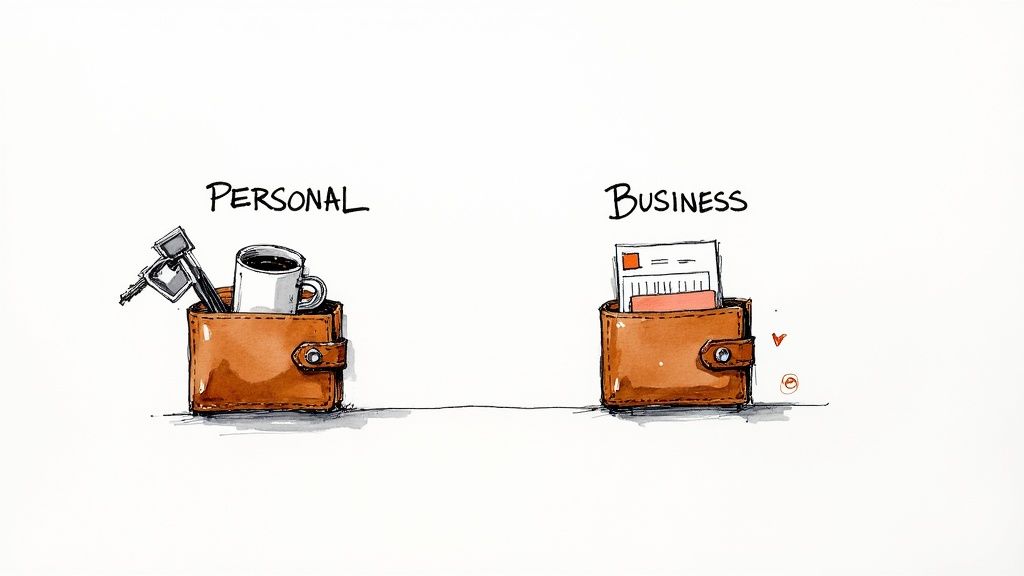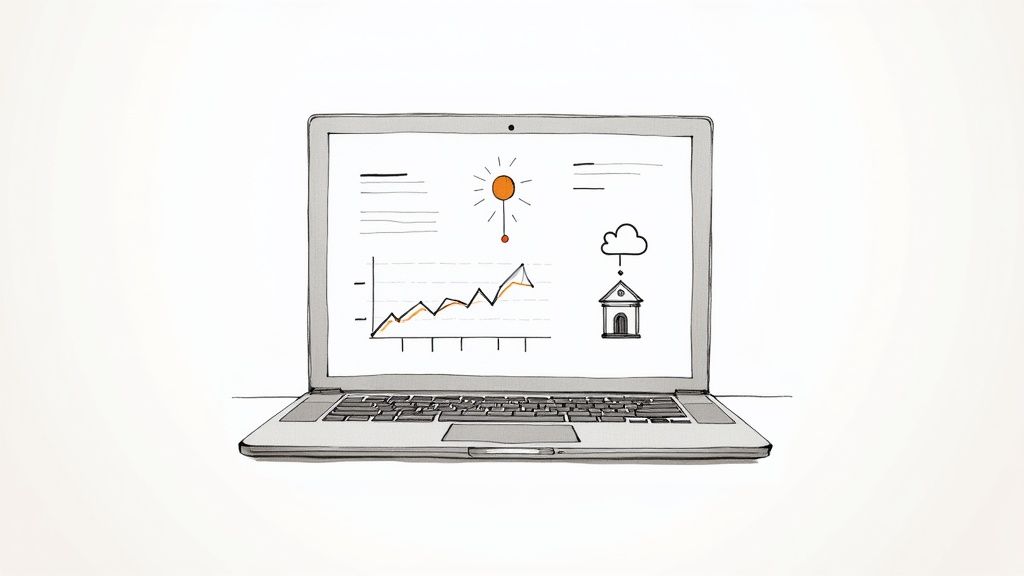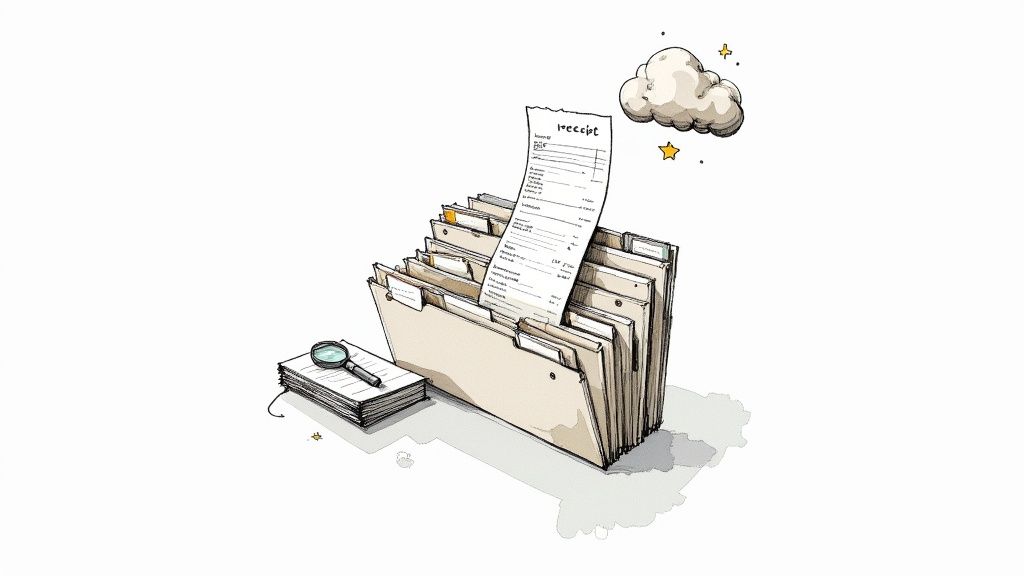
8 Small Business Bookkeeping Tips for 2025
Managing your small business finances can feel overwhelming, but it doesn't have to be. Effective bookkeeping is the bedrock of financial health, providing the clarity needed to make smart decisions, secure funding, and navigate tax season with confidence. Many entrepreneurs get bogged down by messy records and missed deductions, leaving money on the table and creating unnecessary stress. This guide cuts through the noise and gets straight to the point.
We've compiled a list of actionable, straightforward small business bookkeeping tips designed to help you build a solid financial foundation from day one. Instead of generic advice, you'll find practical steps for everything from separating your finances and tracking expenses to reconciling accounts and preparing for taxes. This is not about becoming a certified accountant overnight; it's about implementing simple, consistent habits that yield powerful results.
By following these tips, you can stop reacting to financial surprises and start proactively managing your money. You'll gain a clear picture of your cash flow, understand your profitability, and make informed strategic decisions that drive growth. Let's transform your financial chaos into a streamlined, powerful asset for your business.
1. Separate Personal and Business Finances
The single most important step you can take for accurate small business bookkeeping is to create a clear boundary between your personal and business finances. This means opening a dedicated business bank account and using a separate credit card for all company-related expenses. Commingling funds, or mixing personal and business transactions in one account, is a recipe for accounting chaos, tax-time headaches, and potential legal risk.

This separation creates a clean, undeniable record of your business's financial activity. It simplifies the process of tracking income and expenses, makes tax preparation significantly easier, and provides a clear audit trail should you ever need one. More importantly, for incorporated businesses like LLCs or S-corps, it helps maintain the "corporate veil" that protects your personal assets from business liabilities and lawsuits.
Why This Is a Top Priority
Imagine a freelance consultant who uses a personal account for the first year of business. Come tax time, their accountant has to spend dozens of hours painstakingly sorting through hundreds of transactions, distinguishing between grocery runs and client lunches. This effort can easily cost thousands in accounting fees, wiping out a significant portion of their hard-earned profit.
By contrast, a small retail shop owner who opens a business checking account from day one has a clean, transaction-by-transaction record. This clarity not only saves money on accounting but also provides a real-time, accurate view of the business's financial health.
Actionable Steps to Take
- Open a dedicated business bank account before you make your first sale or incur your first expense. This is a non-negotiable first step.
- Get a business credit card and use it exclusively for company purchases, from inventory to software subscriptions. This also helps build business credit.
- Set up a formal payment system for yourself. Instead of randomly pulling money out, pay yourself a consistent salary or owner's draw via scheduled transfers from your business account to your personal one.
- Link only your business accounts to your bookkeeping software. This automates transaction importing and prevents personal spending from muddying your financial reports.
2. Use Accounting Software
While spreadsheets might seem sufficient at first, relying on them for bookkeeping is like trying to build a house with only a hammer. Modern cloud-based accounting software is the essential toolkit that automates tedious tasks, minimizes human error, and provides an invaluable real-time view of your business's financial health. Platforms like QuickBooks, Xero, and FreshBooks have become the standard for a reason: they empower you to manage your finances professionally without needing a full-time accountant.

This technology acts as your central financial hub. By connecting directly to your business bank accounts and credit cards, it automatically imports transactions, categorizes expenses, and generates critical reports like Profit & Loss statements and Balance Sheets with a few clicks. This automation frees up your time and provides the clear, accurate data you need to make smart business decisions, secure loans, and prepare for tax season with confidence.
Why This Is a Top Priority
Consider a freelancer who tracks income and expenses in a complex spreadsheet. They spend hours each month manually entering data, triple-checking formulas, and worrying about accidental deletions. When it's time to file taxes, they realize they miscategorized hundreds of dollars in expenses, leading to a frantic and stressful scramble to correct the records and a potentially costly overpayment.
In contrast, a small service business using a platform like Xero can reduce their month-end closing process from five days to just one. The software automatically syncs transactions, remembers categorization rules, and provides a clear dashboard view of cash flow. This efficiency not only saves immense time but also provides the owner with an accurate, up-to-the-minute understanding of their company's performance.
Actionable Steps to Take
- Set up automatic bank feeds immediately. This is the most powerful feature, eliminating the bulk of manual data entry and ensuring no transaction is missed.
- Choose software that integrates with your other tools, such as your point-of-sale (POS) system, payment processor (like Stripe or Square), and payroll service.
- Use invoicing and payment features. Create and send professional invoices directly from the software and allow clients to pay online, which automates payment tracking and reconciliation.
- Create rules for recurring transactions. Teach your software to automatically categorize regular expenses like software subscriptions or rent payments to save time each month.
- Schedule time to review your reports. Use the automated reporting tools to regularly check on your cash flow, profitability, and outstanding invoices.
3. Track Expenses Immediately
One of the most costly bookkeeping mistakes is waiting to record expenses. Tracking business expenses the moment they occur creates an accurate, real-time financial picture and prevents lost receipts or forgotten transactions. This immediate approach enables smarter financial decision-making, maximizes tax deductions, and drastically reduces the stress of month-end or year-end reconciliation.

Failing to track expenses promptly means you are likely leaving money on the table. Small, miscellaneous purchases add up quickly, and without a disciplined system, hundreds or even thousands of dollars in legitimate tax deductions can be lost. Real-time expense tracking transforms bookkeeping from a dreaded quarterly chore into a simple, manageable daily habit.
Why This Is a Top Priority
Consider a small consulting firm that tries to reconstruct its mileage logs quarterly. The owner might recall major client visits but forget smaller, local trips, ultimately claiming only $800 in vehicle deductions. By contrast, a consultant who uses a mileage app to track trips daily easily documents enough travel to claim over $3,500 in deductions.
Similarly, a restaurant owner who scans supplier invoices and receipts immediately captures 15-20% more in legitimate meal and supply deductions than one who shoves them in a shoebox. This proactive habit directly impacts your bottom line by ensuring every eligible expense is accounted for.
Actionable Steps to Take
- Implement a "receipt photo" rule. Before you even leave the store or click "confirm purchase," take a clear photo of the receipt with your smartphone.
- Use a receipt scanning app. Tools like Expensify or dedicated receipt generators can automate the process of capturing and categorizing expense data, saving significant time. If you ever need to create a record for a lost receipt, you can generate custom receipts for your records.
- Establish a daily or weekly routine. Set aside 10 minutes at the end of each day or 30 minutes every Friday to review, categorize, and log all expenses from the period.
- Categorize expenses on the spot. When you enter an expense, assign it to the correct category (e.g., "Office Supplies," "Software," "Travel") immediately. This makes generating financial reports effortless.
- Use a dedicated business credit card. This creates an automatic digital trail of most transactions, simplifying the tracking process.
4. Reconcile Bank Accounts Monthly
Bank reconciliation is the process of matching the transactions in your accounting software with the transactions listed on your official bank and credit card statements. This critical monthly check-up ensures that your books are an exact mirror of your financial reality. It’s your primary defense against errors, fraud, and the slow drift of financial inaccuracies that can lead to poor business decisions.
Think of it as a quality control step for your finances. This process confirms that the money you think you have is the money you actually have. It catches everything from bank errors and unauthorized transactions to simple data entry mistakes, like a misplaced decimal or a duplicate expense entry. Without regular reconciliation, your financial reports, including your profit and loss statement and balance sheet, are based on unverified data, making them unreliable.
Why This Is a Top Priority
Imagine a small retail business that diligently records every sale. A customer returns an item, and the refund is processed via a generic POS receipt. A few weeks later, the owner notices the cash balance in their books seems higher than what's in the bank. During the monthly reconciliation, they discover the $250 refund was never entered into the accounting software, creating a discrepancy. Catching this small error prevents a chain reaction of inaccurate reports.
In another scenario, a consulting firm's monthly reconciliation caught a $2,400 unauthorized transaction. Because they reconciled promptly, they were able to report the fraud to their bank immediately, preventing further losses. These examples highlight how this simple monthly habit is one of the most effective bookkeeping tips for maintaining data integrity and protecting your assets.
Actionable Steps to Take
- Schedule a recurring time for reconciliation, ideally within the first week after a month ends, while transactions are still fresh in your mind.
- Use your accounting software’s bank feed to automate the matching process. Most platforms can automatically match over 90% of your transactions, drastically reducing manual work.
- Investigate every discrepancy, no matter how small. A tiny unexplained difference could be a sign of a larger, systemic issue.
- Pay close attention to timing differences, such as checks you've written that haven't been cashed yet (outstanding checks) or deposits that are still processing.
- Save your reconciliation reports. Keep a digital or physical copy of each completed reconciliation statement as part of your permanent financial records for audit purposes. You might need these to cross-reference transactions, such as those documented with a generic POS receipt.
5. Maintain Organized Receipt Systems
A shoebox stuffed with faded thermal paper is no longer a viable receipt management strategy. Maintaining a systematic receipt system, whether digital or physical, is crucial for accurate bookkeeping and tax compliance. This practice ensures you can substantiate every expense during an audit, correctly categorize spending for accurate financial reports, and claim all the deductions you're entitled to. The IRS requires clear documentation for business expenses; an organized system is your first line of defense.

Failing to keep organized receipts means leaving money on the table and exposing your business to risk. Without proof of purchase, deductions can be disallowed, leading to a higher tax bill and potential penalties. A well-managed system transforms receipts from a cluttered nuisance into a powerful data source for understanding your business's spending habits and financial health. This level of organization is one of the most effective small business bookkeeping tips for long-term stability.
Why This Is a Top Priority
Consider a construction contractor whose office was renovated. During the chaos, a box of receipts from the past year was misplaced, resulting in over $5,000 in disallowed deductions for materials and subcontractor payments. Had those receipts been scanned and backed up digitally from the start, the financial loss would have been completely avoidable.
In contrast, a marketing agency that uses a receipt-scanning app for all employee expenses reduced its reimbursement processing time by 80%. This not only saved administrative hours but also improved the accuracy of their expense categorization, giving them a clearer picture of project costs and profitability.
Actionable Steps to Take
- Go digital immediately. Use a dedicated receipt scanning app like Expensify, Dext, or even Adobe Scan on your phone to capture receipts the moment you get them. This prevents loss and fading.
- Create a logical folder structure. Organize digital receipt files by year, then by month, and finally by expense category (e.g., "2024 > 09-September > Office Supplies").
- Annotate key details. For significant or ambiguous expenses, write the specific business purpose directly on the physical receipt before scanning or add a note to the digital file.
- Back up your records. Store digital copies in at least two secure locations, such as a cloud service (Google Drive, Dropbox) and a physical external hard drive. The IRS requires you to keep records for up to seven years.
- Get the right documentation. Always request an itemized receipt that shows what you purchased, not just the credit card slip that only shows the total. If you need to create a record, you can explore various receipt templates to ensure you capture all necessary information.
6. Create a Budget and Monitor Cash Flow
Profitability on paper doesn't pay the bills; cash in the bank does. This is why creating a budget and actively monitoring cash flow are two of the most critical small business bookkeeping tips. A budget acts as your financial roadmap, forecasting your expected income and expenses, while cash flow monitoring tracks the actual movement of money in and out of your business, ensuring you have the liquidity to operate.
Many small businesses fail not from a lack of customers or profit but from poor cash flow management. They run out of money to pay suppliers, rent, or payroll, even while waiting for large client payments to arrive. By combining budgeting with cash flow analysis, you can anticipate potential shortfalls, make informed spending decisions, and identify opportunities for growth before they become problems.
Why This Is a Top Priority
Consider a seasonal landscaping company that is highly profitable from spring to fall but has minimal income in the winter. By creating a cash flow forecast, the owner realized they would face a significant cash shortage in February. Armed with this knowledge, they secured a small line of credit and adjusted non-essential expenses during the slow months, successfully navigating the off-season without any disruption to their core operations.
Without this foresight, the business could have easily defaulted on loan payments or been unable to pay key employees, jeopardizing its ability to ramp up for the profitable spring season. This proactive approach turns bookkeeping from a historical record into a powerful strategic tool.
Actionable Steps to Take
- Develop a detailed annual budget based on historical data and future goals. Break it down into monthly targets for both revenue and expenses.
- Create a cash flow forecast. Project your cash inflows (from sales, receivables) and outflows (payroll, rent, inventory) for the next 3-6 months.
- Review your budget vs. actuals monthly. Analyze where you overspent or undershot revenue projections and understand the reasons behind the variances.
- Track your accounts receivable aging. Actively follow up on overdue invoices, as late payments are a primary cause of cash flow problems.
- Build a contingency fund. Aim to keep a cash reserve equivalent to 3-6 months of essential operating expenses to cover unexpected costs or revenue dips.
7. Invoice Promptly and Follow Up on Payments
One of the most critical aspects of managing your cash flow is getting paid on time. Invoicing promptly and consistently following up on outstanding payments are not just administrative tasks; they are essential actions that directly impact your business's financial stability. Slow invoicing and a passive approach to collections can starve your business of the cash it needs to operate, pay bills, and grow.
This practice ensures that revenue is recognized and received as close to the point of sale or service completion as possible. It shortens your cash conversion cycle and reduces the risk of bad debt. Furthermore, a professional and persistent invoicing process signals to clients that you are a serious, well-managed business, which can improve payment behavior over the long term.
Why This Is a Top Priority
Imagine a freelance web developer who completes a project but waits two weeks to send the invoice. The client's 30-day payment term only begins once they receive that invoice, meaning the developer won't see that cash for over six weeks after finishing the work. This delay can create a significant cash flow gap, making it difficult to cover immediate business expenses.
By contrast, a consulting firm that invoices the same day a project milestone is hit dramatically reduces its Days Sales Outstanding (DSO). By implementing automated payment reminders, they ensure clients are nudged politely and professionally, collecting payments nearly 30% faster without any manual effort. This proactive approach is a cornerstone of effective small business bookkeeping tips for maintaining healthy cash reserves.
Actionable Steps to Take
- Invoice immediately upon completing a job or shipping a product. Don't wait until the end of the week or month.
- Include clear payment terms on every invoice, such as "Due on Receipt" or "Net 15," along with the specific due date.
- Offer multiple payment options like credit cards, bank transfers (ACH), and online payment gateways to make it easy for clients to pay you.
- Use accounting software to automate reminders. Schedule a polite reminder to be sent 3-5 days after the due date, with weekly follow-ups thereafter.
- Consider offering an early payment discount, such as 2% off if paid within 10 days, to incentivize prompt payment.
- Require a deposit for large projects or new clients to secure initial cash flow and reduce your financial risk.
8. Understand and Leverage Tax Deductions
One of the most impactful small business bookkeeping tips is to proactively understand and claim every tax deduction you are legally entitled to. A tax deduction is a business-related expense that you can subtract from your gross income, which lowers your taxable income and, consequently, your tax bill. Many small business owners leave thousands of dollars on the table each year by overlooking common and industry-specific deductions.
Effective bookkeeping is the foundation for maximizing these deductions. Without a clean, accurate, and complete record of your expenses, you have no way to prove or even identify what you can claim. Diligent tracking and categorization are not just for monitoring your business's health; they are your primary tools for legally minimizing what you owe to the government.
Why This Is a Top Priority
Consider a freelance graphic designer who drives to meet clients and buys new design software. By meticulously tracking vehicle mileage, they could claim a significant deduction. For 10,000 business miles at the IRS rate (e.g., $0.67 per mile), that’s a $6,700 deduction. Add a $3,000 deduction for professional development courses and software, and they’ve reduced their taxable income by nearly $10,000.
Without proper bookkeeping, these expenses might be forgotten or lack the documentation required for an audit. This single tip can directly translate into thousands of dollars in tax savings, freeing up cash flow that can be reinvested into growing the business.
Actionable Steps to Take
- Track all potential deductions. Keep detailed records of common expenses like office supplies, software subscriptions, advertising costs, and professional fees.
- Maintain a mileage log. Use a dedicated app or a simple logbook to record the date, purpose, and miles for every business-related trip. Do this in real-time, not at the end of the year.
- Document your home office. If you use a part of your home exclusively for business, measure its square footage and take photos. This supports the home office deduction.
- Keep meticulous receipts. Use a tool to capture and categorize every receipt for deductible purchases, especially for meals, travel, and entertainment, noting the business purpose on each.
- Consult a tax professional. Work with an accountant to identify all deductions specific to your industry and ensure you are claiming them correctly and have the proper documentation.
8-Point Small Business Bookkeeping Comparison
| Item | 🔄 Implementation Complexity | ⚡ Resource Requirements | 📊 Expected Outcomes | Ideal Use Cases | ⭐ Key Advantages / 💡 Quick Tip |
|---|---|---|---|---|---|
| Separate Personal and Business Finances | Low — simple setup, requires discipline | Low — business account, possible fees | Clear audit trail; simpler taxes; liability separation | Freelancers, LLCs, small businesses | Legal protection and cleaner reporting ⭐; Open a business account before first transaction 💡 |
| Use Accounting Software | Medium — setup and learning curve | Medium — subscription, integrations, training | Automated reports; fewer errors; faster close | Growing SMBs, multi-user teams, recurring billing | Scales operations and saves time ⭐; Integrate with bank and train users 💡 |
| Track Expenses Immediately | Medium — daily habit and process | Low–Medium — mobile app or manual time | Maximizes deductions; accurate real-time data | High-volume transactions, frequent travel or purchases | Prevents missed deductions and errors ⭐; Capture receipts within 24 hours 💡 |
| Reconcile Bank Accounts Monthly | Medium — regular monthly process | Low–Medium — time or automated tools | Detects fraud/errors; ensures record accuracy | Any business with bank activity; audit prep | Confirms financial truth and catches discrepancies ⭐; Reconcile within 5–10 days of month-end 💡 |
| Maintain Organized Receipt Systems | Medium — initial setup + ongoing maintenance | Low–Medium — scanner/app, cloud storage | Audit-ready documentation; recover deductions | Receipt-heavy businesses; audit-prone operations | Preserves proof and simplifies reporting ⭐; Back up digital copies in 2 locations 💡 |
| Create a Budget and Monitor Cash Flow | Medium–High — forecasting and updates | Medium — time, forecasting tools, historical data | Prevents cash shortages; informed decisions; scenario planning | Seasonal businesses, startups, growth planning | Improves liquidity and planning accuracy ⭐; Update forecasts quarterly; keep contingency reserve 💡 |
| Invoice Promptly and Follow Up on Payments | Low–Medium — process + collections | Low–Medium — invoicing tools, time for follow-up | Faster payments; reduced DSO; better cash flow | Service providers, freelancers, B2B suppliers | Accelerates receivables and reduces bad debt ⭐; Automate reminders and offer early-payment discounts 💡 |
| Understand and Leverage Tax Deductions | High — complex rules and documentation | Medium–High — time, possibly tax professional | Lower taxable income; significant tax savings when compliant | All businesses seeking tax optimization | Substantial tax savings if documented correctly ⭐; Work with a CPA and keep meticulous records 💡 |
Putting Your Financial Plan into Action
Navigating the world of small business bookkeeping can feel like a monumental task, but it doesn't have to be. The journey from financial chaos to clarity is built on small, consistent habits, not a single, grand overhaul. Throughout this guide, we've explored a series of foundational yet powerful small business bookkeeping tips, each designed to give you more control, insight, and confidence in managing your company's finances.
Remember, the goal isn't just to record transactions; it's to build a resilient and predictable business. By diligently separating personal and business finances, you create a clear boundary that simplifies everything from expense tracking to tax preparation. Adopting the right accounting software transforms bookkeeping from a manual chore into a streamlined, automated process, saving you invaluable time and reducing the risk of human error.
From Tips to Tangible Results
The real magic happens when you integrate these practices into your daily, weekly, and monthly routines. Immediate expense tracking, a core habit we discussed, ensures no deduction is missed and your financial records are always up-to-date. This simple action, combined with monthly bank reconciliation, provides a regular health check for your business, allowing you to catch discrepancies early and maintain an accurate picture of your cash flow.
Think of these tips not as individual tasks but as interconnected parts of a larger financial system:
- Organized receipts are the primary evidence for your expense claims.
- Prompt invoicing directly impacts your cash flow.
- Understanding tax deductions ensures you don't overpay the government.
- A clear budget acts as your financial roadmap, guiding your spending and strategic decisions.
Mastering these concepts is about more than just compliance; it's about empowerment. When you have a firm grasp on your numbers, you can make smarter, data-driven decisions. You can confidently invest in growth, prepare for slow seasons, and build a business that is not only profitable but also sustainable for the long term.
Your Actionable Next Steps
Don't feel pressured to implement every single tip overnight. The most effective approach is to build momentum. Start by choosing one or two areas that feel most urgent.
- This Week: Commit to separating your business and personal bank accounts if you haven't already. It is the single most impactful first step.
- This Month: Schedule a recurring time on your calendar to perform your first monthly bank reconciliation. Treat this appointment as seriously as you would a client meeting.
- This Quarter: Create a simple budget and begin tracking your cash flow against it. This will reveal powerful insights into your business's financial patterns.
By breaking down the process, you turn an intimidating project into a series of manageable achievements. The clarity you gain today is an investment in your future success. Your future self, especially during tax season or when applying for a business loan, will thank you for the robust financial foundation you are building right now.
Ready to master your expense tracking and receipt management? ReceiptMake helps you create professional, customized receipts in seconds, ensuring your records are always organized and complete. Stop chasing down lost paper and start building a perfect audit trail today with ReceiptMake.
Article created using Outrank

